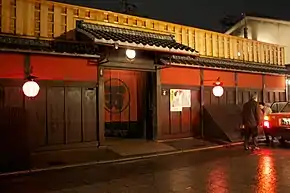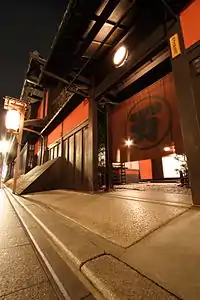Ichiriki Chaya
Ichiriki Chaya (一力茶屋, Ichiriki Teahouse), formerly Ichiriki-tei (一力亭, Ichiriki Mansion), is an historic ochaya (English: Geisha "tea house") in Kyoto, Japan. It is located at the southeast corner of Shijō Street and Hanami Lane, its entrance right at the heart of the Gion Kobu district.

It is considered an exclusive and high-end establishment; access is invitation only while its fame is often associated with the Chushingura event. The ninth teahouse proprietor is Jirou-emon Sugiura.
History
The Ichiriki is over 300 years old, and has been a major centerpiece of Gion since the beginning of the entertainment district. Like other ochaya in Gion, Ichiriki was a place where men of status and power went to be entertained by Geisha, who distracted guests through dancing, banter, and flirtation. Ichiriki has traditionally entertained those of political and business power.
The house is run by the Sugiura (杉浦) family, and the nameplate on the entrance gate reads Sugiura Jirou(u)emon[note 1] (杉浦治郎右衛門), the name of the ninth generation head.[1]
Name
The noren curtain at the entrance features the characters ichi (一, one) and riki (力, strength) printed in black on a dark red ground, stacked vertically and touching, so they resemble the character man (万, myriad, ten thousand). It is said that the establishment was originally called yorozuya (万屋, general store), but in the play Kanadehon Chūshingura (仮名手本忠臣蔵) (a telling of the story of the forty-seven rōnin, based on events at the house – see below) the name was changed by splitting the character into 一 and 力, disguising the name (names were disguised in the play to avoid censorship). Due to the play being a major success, this was then adopted by the house itself, yielding the present name.[1]
The Forty-seven Rōnin
The Ichiriki plays a part in the events of the Akō vendetta, a historical event described by some scholars as a Japanese "national legend".[2] In brief, its story began near the start of the eighteenth century when a group of samurai found themselves left masterless, rōnins, after their daimyō was forced to commit the ritual suicide of seppuku for the crime of drawing a sword and injuring a man in the Imperial Palace.
Kira Yoshinaka had made a series of verbal insults towards the samurai’s master, inciting his attack, but Kira was left unpunished. Because of that injustice, the rōnin samurai plotted to assassinate Yoshinaka for over two years.
The rōnin, led by Oishi Kuranosuke, realized they would be monitored for signs they were planning to enact an attempt at revenge. Thus, in an effort to dissuade the suspecting parties and Imperial spies, they sent Kuranosuke to Kyoto. Kuranosuke spent many nights in Ichiriki Chaya, earning a reputation as a gambler and a drunkard.[3] As Kuranosuke gave the appearance of becoming more and more relaxed and unprepared, Kira became less active in his suspicions and eventually relaxed his security. Because the Ichiriki provided the cover to mount an attack, the rōnin were eventually successful in killing Yoshinaka, but were then forced to commit seppuku themselves.
This story has been retold numerous times, a genre known as Chūshingura, which has served to increase the fame of Ichiriki Chaya.
The Fall of the Shōgun
As modernization spread through Japan during the final years of the Edo period, unrest spread with it; the age of the shōgun was coming to an end.
A series of killings of foreigners had led to tension with the western powers, and this international pressure led many to question the legitimacy of the shōgun’s rule.[4] Much of the plotting to overthrow the Shōgun took place in secretive talks within Ichiriki Chaya, disguised as innocent evenings with friends.[5]
The plans came to fruition in 1868 when the last shōgun agreed to dissolve the shogunate at Nijō Castle.[5]
Access
Access to the Ichiriki is the height of exclusivity; fierce ties to the ochaya must first be established before one can become a patron. Relationships to the ochaya can often be traced back generations, and only these wealthy honored patrons and their guests, with reservations, are allowed in.[6]
For a brief period of only a few nights in 2006, The Ichiriki, along with other ochaya (one from each of the five Kyoto geisha districts), offered general access to a small number of tourists who were unaccompanied by patrons, as part of a tourism promotion program, at the request of the Kyoto City Tourist Association.[7]
Services offered

Services are as usual at ochaya – maiko and geiko are hired from a geisha house (okiya) to provide entertainment, consisting of conversation, flirtation, pouring drinks, traditional games, singing, musical instruments, and dancing.[6] The Ichiriki does not prepare food, but customers can order catering à la carte, which is delivered to the house.[1] Guests can also be shown around the house, and see various decorations, such as a miniature display of the forty-seven ronin, from circa 1850.[6]
Architecture
The Ichiriki is structured in the style of its original traditional Japanese architecture. The structure of the building is mostly wood, and is designed to protect the privacy of its patrons. In fact, the interior gardens are not even visible from outside the complex. Besides sight, the building protects the conversation within with angled screens to prevent eavesdropping at walls.[3]
Cultural References to the Ichiriki
- The establishment is a major setting in Arthur Golden's fictional portrayal of a Gion geisha's life Memoirs of a Geisha, though the mistress says he has never visited the establishment.[6]
- The Ichiriki is a major setting in the kabuki play Kanadehon Chūshingura, depicting the story of the 47 rōnin.[8][9]
- The play Ichiriki Teahouse centers around the plots against the shogun in the Ichiriki.[10]
- Former geisha Sayo Masuda mentions it several times in her work Autobiography of a Geisha,[11] stating that "The Mistress of the Ichiriki was only thirty-four or thirty-five, but she once had been a geisha herself and had suffered terribly to get where she was, so she was kind to us in all sort of ways".
Notes
- Reading of 治郎右衛門 is ambiguous.
References
- 祇園一力亭 (Gion Ichiriki-tei) (in Japanese)
- "Kanadehon". Columbia University.
- "Ichiriki Ochaya." Japan Travel Guide. Ed. Declan Murphy. Hattori Foundation - The Yamasa Inst. 8 July 2008 <http://www.yamasa.org/japan/english/destinations/kyoto/ichiriki_ochaya.html>.
- "The Overthrow of the Shogun 1867." Bigpond. Historical Foundation of Japan's Military Aggression. 8 July 2008 <http://www.users.bigpond.com/battleforAustralia/foundationJapmilaggro/ShogunOverthrown.html>.
- Martin, John H., and Phyllis G. Martin. Kyoto: A Cultural Guide. North Clarendon: Tuttle, 2002.
- Burgess, Steve (13 June 2001). "The powder puff girls". Salon. Retrieved 8 July 2008.
- "Exclusive Kyoto Teahouses Open Doors to Tourists." Yomiuri Shimbun [Tokyo] 30 Jan. 2006: .
- "Ichiriki Teahouse." Kabuki for Everyone. 8 July 2008 <http://park.org/Japan/Kabuki/theater/cyushin.html>.
- Bell, David. Chushingura and the Floating World: The Representation of Kanadehon Chushingura in Ukiyo-e Prints. New York: Rutledge, 2001.
- Strock, Owen. Japanese Visual Culture. Middlebury U. 8 July 2008 <http://w00.middlebury.edu/ID085A/STUDENTS/Edo/johnson.html>.
- MASUDA, Sayo. Autobiography of a Geisha. Columbia University Press, 2003
External links
| Wikimedia Commons has media related to Ichiriki Ochaya. |
- 祇園一力亭 (Gion Ichiriki-tei – article shows pictures of interior, a private dance show, and the house's matchbox) (in Japanese)
- Ichiriki Chaya Photo Gallery